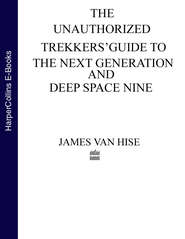По всем вопросам обращайтесь на: info@litportal.ru
(©) 2003-2025.
✖
The Unauthorized History of Trek
Автор
Год написания книги
2018
Настройки чтения
Размер шрифта
Высота строк
Поля
CHAPTER SEVEN (#litres_trial_promo)
SAILING THE SILVER SCREEN (THE MOVIE TRILOGY): (#litres_trial_promo)
One successful motion picture leads to another.
CHAPTER EIGHT (#litres_trial_promo)
A NEW GENERATION EMBARKS: (#litres_trial_promo)
The seemingly impossible task of creating a new version of Star Trek is accomplished.
CHAPTER NINE (#litres_trial_promo)
THE OLD GUARD STUMBLES; THE NEW WAVE TRIUMPHS: (#litres_trial_promo)
Star Trek V goes down for the count while The Next Generation gets better and better.
CHAPTER TEN (#litres_trial_promo)
THE TORCH IS CARRIED ON: (#litres_trial_promo)
The fourth season of The Next Generation produces some of the finest episodes yet and further demonstrates how different the new Star Trek really is.
CHAPTER ELEVEN (#litres_trial_promo)
THE END OF A GENERATION: (#litres_trial_promo)
After seven outstanding years, The Next Generation ends its successful run on television—but still the voyage continues.
CHAPTER TWELVE (#litres_trial_promo)
THE FUTURE BECKONS, BRIGHT AND BOLD: (#litres_trial_promo)
Whither Star Trek?
CHAPTER THIRTEEN (#litres_trial_promo)
CHECKLISTS: (#litres_trial_promo)
Star Trek: The Classic Years, The Animated Voyages; The Next Generation.
KEEP READING (#litres_trial_promo)
ABOUT THE AUTHOR (#litres_trial_promo)
ALSO BY (#litres_trial_promo)
ABOUT THE PUBLISHER (#litres_trial_promo)
FOREWORD (#ulink_543b90e1-f0b2-5495-8ec3-e0116566e6c9)
GENE RODDENBERRY (1921–1991) (#ulink_543b90e1-f0b2-5495-8ec3-e0116566e6c9)
It came as a surprise to many when Gene Roddenberry died of a heart attack on October 24, 1991. While the news that he had suffered a series of strokes during the year had leaked out, the full extent of his illness was not known.
There had been rumors, though, when a gala twenty-fifth anniversary celebration for Star Trek at Paramount was scaled down in September because he was too ill to attend. A couple of actors from the original series had long been rumored to be in frail health, but no one ever thought Roddenberry would be the first to depart.
While some fear that with Roddenberry’s passing the light of Star Trek will die, it has been known for some time that he was all but retired, having stepped down from his on-line duties on The Next Generation more and more as each year passed, until for the last two years he had been little more than a consultant. His involvement with the motion pictures has been minimal since the first one, the only one on which he worked full-time.
Star Trek was a synthesis of many talents. While it was created by Roddenberry years ago, it was developed by such people as Gene Coon, Dorothy Fontana, and others whose contributions added much to the legend. While Roddenberry had the original vision and steered the ship on a true course, he was not the only one to dream the dream, and his biggest gift was to inspire others. The many forms of Star Trek over the years serve as living testimonial.
When people die there is the danger of their being elevated to a role they never had in life or never aspired to. One should not suddenly elevate Roddenberry to godhood. Gene was a man, with the foibles of a man, but he should never be forgotten for his many abilities, and most of all for his dream, a dream he shared with so many of us. This dream will insure that Gene Roddenberry will never be forgotten.
JAMES VAN HISE
INTRODUCTION (#ulink_29197010-5789-5ac5-94fd-fbe62446559d)
A PHENOMENON UNEXCELLED (#ulink_29197010-5789-5ac5-94fd-fbe62446559d)
Star Trek. These two simple words bring forth a vast web of mental associations to millions of people. For more than twenty-five years, a remarkable and widely varied group of characters has seemingly taken over a sizable portion of our collective consciousness and made it its own. Perhaps the late science fiction visionary Philip K. Dick saw this when he had a character in his novel A Scanner Darkly refer to the latest entertainment extravaganza as a “captainkirk.”
More than thirty years after Gene Roddenberry first envisioned the world of the starship Enterprise, the traces of the original series are everywhere. Kirk and crew have become icons in American popular culture, representing the best of our dreams: adventure, exploration, the triumph of the human spirit over all kinds of adversity. Current films and television series continue to refer to Star Trek, and in the 1991 feature film Bill and Ted’s Bogus Journey William Shatner is honored as a guest star when the movie’s heroes are seen watching “The Arena.”
Clearly, Star Trek has risen above the fate of other past television programs. This is a show to which some people have dedicated more than twenty-five years of their lives, often making Star Trek a centerpiece of their own personal philosophies and mythologies. This is a show that has refused to die. Battling network muddleheadedness in the sixties, creator Gene Roddenberry thought that his dream had died after its third season.
Fortunately, nothing could undermine or destroy Star Trek’s unique appeal. Rather than fade gracefully away into the dusty attic of quaint and anachronistic conceits, Star Trek continued to live and breathe. With only seventy-nine episodes aired, the myth of Star Trek built around the dedication of its fans as well as an undying fascination with a television show that had shown viewers such strange new worlds. Even Roddenberry was somewhat taken aback by the support his creation gathered as the years went by; it began to seem inevitable that Star Trek would return someday, and overcome the many impediments that blocked its path.
Star Trek brought fortune and fame to a handful of actors who had for years been laboring in obscurity: William Shatner, Leonard Nimoy, DeForest Kelley, Nichelle Nichols, James Doohan, George Takei, and Walter Koenig. Without their talents, this unique television legacy would never have survived. Instead of fading into celluloid, these actors became a surrogate family, a group of faithful and fascinating friends to a generation, and, now, to that generation’s children.
Though some found the 1979 release of Star Trek: The Motion Picture to be disappointing, the movie’s tepid reviews could not slow down the rampaging phenomenon of Star Trek’s popularity. Fans remained as involved as ever, and were irate at Spock’s death in The Wrath of Khan and the destruction of their beloved Enterprise in The Search for Spock. No amount of irritation or criticism could keep Trekkers out of the movie theaters, however, and hard-core fans began to share seat space with a new generation, born in the time since Kirk’s last journey. Disgruntlement among the fans was overcome by loyalty, and eventually passed into the legend of Star Trek.
The original Enterprise crew had been busy in the intervening years. In 1986, when the fourth, and most successful, movie was released, fans were thrilled to find Leonard Nimoy in the director’s chair. The lighthearted approach, combined with a compelling and timely Enterprise mission to Earth’s history, served to bring yet more new fans into the Star Trek fold.
Rumors of a new Star Trek incarnation abounded for nearly twenty years, and 1987 finally brought the debut of the Enterprise D, a Galaxy-class starship, in Star Trek: The Next Generation. Launched on Stardate 2363, some one hundred years after the last voyage of the now legendary Captain Kirk, the new Enterprise was a sleek beauty that never forgot her roots in rough-and-ready adventure. Captained by Patrick Stewart as Jean-Luc Picard, the new Enterprise would have strong ensemble acting by Jonathan Frakes, Brent Spiner, Gates McFadden, Marina Sirtis, LeVar Burton, Denise Crosby, and Michael Dorn. Like their predecessors on the bridge, the names of this crew rapidly became household words, their characters and actions debated, analyzed, applauded, and criticized.
The launch of the Enterprise D set off a raging, still-unresolved debate about which captain and crew best exemplified the dream of Star Trek. Fans took sides immediately and began fantasizing about a meeting, and an inevitable fight, between the two captains. If some fans found the new product unpalatable. Star Trek: The Next Generation widened the fold, and in its seven-year run garnered its own acclaim, awards, and admirers.
Gene Roddenberry’s dream continued to explore strange new worlds, and in 1993, two years after its creator’s death, Star Trek gave birth to Star Trek: Deep Space Nine, a new weekly series set in a permanent orbiting space station. The world of Trek met Avery Brooks as Commander Sisko, with actors Rene Auberjonois, Nana Visitor, Terry Farrell, Siddig El Fadil, Armin Shimerman, and Colm Meaney to man the station.
Two more movies, Star Trek V: The Final Frontier (1988), and Star Trek VI: The Undiscovered Country (1991), kept fans in the theaters, when they weren’t home watching Picard in first-run shows and Kirk and Spock in popular reruns.
Star Trek: The Next Generation saw its final broadcast in 1994, but fans had been promised a movie. The autumn release of Star Trek: Generations may have been weak critically, but fans were treated to a long-awaited meeting of Picard and Kirk. The long-debated “battle of the captains” did not materialize, as the movie showed the two Enterprise captains working together in a spirit of cooperation, not conflict. Like other Trek movies, Generations itself was born in conflict, and fans missed the presence of Leonard Nimoy and DeForest Kelley.
If Kirk seemed to be passing the torch, although with chagrin, to Picard, Star Trek: The Next Generation found its own child in the launch of yet another weekly series. In January 1995, Paramount launched its own broadcast network, UPN, with the maiden voyage of Star Trek: Voyager. The starship Voyager is thrown nearly eighty million light-years from home, and the new series chronicles the ship’s travels as it makes its way back to Federation space. Captain Kathryn Janeway has already been compared to both James T. Kirk and Katharine Hepburn. Actress Kate Mulgrew and crew, confident and excited, are gearing up for the inevitable scrutiny of Star Trek’s legendary fandom.
On inheriting Gene Roddenberry’s formidable responsibility and vision, Executive Producer Rick Berman told TV Guide in the spring 1995 special edition, “We would be crazy if we always sat around saying to ourselves, ‘Now what would Gene have done about this?’ I owe him a great deal, and part of that debt is to keep his vision as true as I can—but not so rigidly that Star Trek doesn’t grow.”
All Star Trek fans owe Roddenberry a great deal of love and admiration for his creativity, dedication, and integrity. While Star Trek began as a concept that few thought would ever get off the ground, the starship Enterprise became the flagship of a fleet of wondrous ships and stories that after nearly thirty years continue, almost unbelievably, to boldly go where no one has gone before. This book will take you on that journey, from Roddenberry’s first idea to the final frontier.






